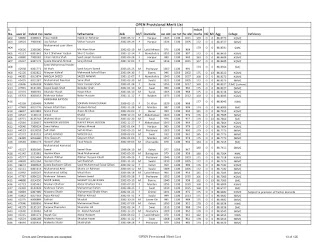Periodic Classification of Elements & Periodicity MCQS
CHAPTER # 1
Periodic
Classification of Elements & Periodicity
1. Which of the following pairs are
chemically
dissimilar?
(A) Na and K (B) Ba and Sr
(C) Zr and Hf (D) Ca and Zn.
2. The total number of inner
transition elements
is
(A) 10 (B) 14
(C) 28 (C) 30
3. The alkali metal which is liquid at
15oC is
(A) K (B) Cs
(C) Na (D) None
4. Which of the following ion will
form most water
soluble hydroxide?
(A) K+ (B) Ni2+
(B) Zn2+ (C) Al3+
5. Which of the following has greatest
tendency
to lose electron?
(A) F (B) Fr
(B) S (C) Be.
6. The oxide of which of the following
elements
will be acidic in character
(A) Mg (B) Rb
(C) Li (C) CI
7. Which of the following is
isoelectronic with
carbon atom?
(A) Na+ (B) Al3+
(C) O2
- (D) N+
8. Which of the following ions are
paramagnetic
in character?
(A) Zn2+ (B) Cu+
(C) Ni2+ (D) Ag+
9. Ca2+ ion is isoelectronic with
(A) Mg2+ (B) Na+
(C) Ar (D) Kr
10. Gradual addition of electronic
shells in the
noble gases causes a decrease in their
(A) Ionization energy (B) atomic
radius
(C) Boiling point (D) density.
11. Which of the following has highest
first
ionization potential?
(A) Carbon (B) Oxygen
(C) Nitrogen (C) Boron.
12. Which of the following has the
smallest size?
(A) Na+ (B) Mg2+
(C) Al3+ (D) CI
13. Which of the following element has
the
maximum electron affinity?
(A) F (B) S
(C) I (D) CI.
14. Which of the following is
isoelectronic as well
as has the same structure as that of
N2O ?
(A) N3H (B) H2O
(B) NO2 (C) CO2
15. The atomic radius increases as we
move
down a group because
(A) Effective nuclear charge increases
(B) Atomic mass increases
(C) Additive electrons are
accommodated in
new electron level
(D) Atomic number increase.
16. Which one of the following is an
incorrect
statement?
(A) The ionization potential of
nitrogen is
greater than that of chlorine
(B) The electron affinity of fluorine
is greater
than that of chlorine
(C) The ionization potential of
beryllium is
greater than that of boron
(D) The electronegativity of fluorine
is greater
than that of chlorine.
17. Electron affinity depends on
(A) Atomic size
(B) Nuclear charge
(C) Atomic number
(D) Atomic size and nuclear charge
both.
18. Two elements whose
eletronegativities are 1.2
and 3.0, the bond formed between them
would
be
(A) Ionic (B) covalent
(C) Coordinate (C) metallic.
2
19. Ionic radii are
(A) Directly proportional to square of
effective
nuclear charges
(B) Inversely proportional to
effective nuclear
charge
(C) Inversely proportional to square
of
effective nuclear charge
(D) Directly proportional to effective
nuclear
charge.
20. Which of the following oxides is
atmospheric in
character?
(A) CaO (B) CO2
(C) SiO2 (D) SnO2
21. Mark the correct statement:
(A) Na+ is smaller than Na atom
(B) Na+ is larger than Na atom
(C) CI- is smaller than CI atom
(D) CI- and CI are equal in size
22. Who introduced the zero groups?
(A) Lothar Meyer (B) Lockery
(C) Mendleev (D) Ramsay
23. Element, of group I-B are called
(A) Representative elements
(B) Transition elements
(C) Rare earth
(D) Coinage metals
24. The element with Z = 24 is placed
in the period
(A) 5 (B) 2
(C) 3 (D) 4
25. Which is the part of metalloids?
(A) NA and K (B) F and CI
(C) None of these (D) Cu and Au
26. Which one of the following has the
maximum
electron affinity?
(A) I (B) Br
(C) CI (D) F
27. On electrolysis of NaH, hydrogen
is liberated
(A) At anode (B) in the electrolyte
(C) At cathode (D) none of them
28. Elements with greater number of
electrons
have _________values of ionization
energy.
a) Only one b) More than one
c) Zero d) Infinite
29. Which of the following possess
maximum
hydration power?
a) Na+ b) K+
c) Mg+2 d) Ca+2
30. Higher value of electron affinity
means_________
a. Atom will lose electron easily
b. Atom will gain electron easily
c. Atom may form di-positive ion
d. The reason is unknown
31. Melting points of VII-A group
___________
down the group
a. Increase b Decrease
c. Remain constant d. No regular trend
32. Oxidation state of an atom
represents______
a. No. of electrons gained
b. No. of electrons lost
c. No. of electrons gained or lost
d. None of above correctly represent
it
33. Mendeleev’s periodic table was
based on
a) Atomic number b) Atomic mass
c) Atomic volume d) Electronic
configuration
34. Elements present in a same group
have the
same
a) Atomic number
b) Molecular weight
c) Chemical properties
d) Electronic configuration
35. “s” and “p” block elements are
also called
a) Transition elements
b) Inert elements
c) Typical elements
d) Rare earth elements
36. What is the symbol of the element
with only
three electrons and three protons?
a) Li b) C
c) Ag d) Cu
37. Elements with seven electrons in
their valence
shell are known as
a) Inert b) Lanthanides
c) Halogens d) Alkali metals
3
38. Which of the following pairs of
elements are
chemically most similar?
a) Na and Al b) Cu and Cu
c) S and F d) Sc and Zn
39. A student of chemistry will
identify positively
the following symbols as sodium
a) W2
3
11
b) X4
0
19
c) Y2
6
13
d) Z3
2
16
40. In the periodic table each period
begins with a
metal, which is
a) Most electronegative
b) Most electropositive
c) Less electropositive
d) Less electronegative
41. Which one of the following is not
a coinage
metal?
a) Au b) Cu
c) Ag d) Pd
42. Which is the most metallic element
of 2nd
period?
a) Lithium b) Beryllium
c) Boron d) Carbon
43. The outer most orbital involved in
chemical
bonding is called
a) Molecular orbital b) Complete
orbital
c) Valence orbital d) Free orbital
44. Elements, which form basic oxides
are
a) Electropositive b) Electronegative
c) Inert d) None of these
45. Which of the following has the
most basic
character?
a) Na2O b) MgO
c) Al2O3 d) P2O3
46. Which of the following is smallest
in size?
a) K+1 b) O-2
c) F-1 d) Na+
47. Ionization energy is lowest for
a) Inert gases b) Halogens
c) Alkali metals d) Alkaline earth
metals
48. An isotope of hydrogen is
a) Neptunium b) Plutonium
c) Thorium d) Tritium
49. With respect to chlorine, hydrogen
will be
a) Electropositive b) Electronegative
c) Neutral d) None of these
50. Which of the following has the
highest electron
affinity?
a) 1S2 2S2 2P3 b) 1S2 2S2 2P6 3S1
c) 1S2 2S2 2P5 d) 1S2 2S2 2P5
51. Excluding hydrogen and helium, the
smallest
elements in the periodic table is
a) Lithium b) Fluorine
c) Cesium d) Iodine
52. Which halogen has the smallest
electron
affinity?
a) F b) Cl
c) Br d) I
53. The element with atomic number 7
is likely to
have same properties to the element
whose
atomic number is
a) 11 b) 2
c) 15 d) F
54. Which of the following will have
largest size?
a) Br b) I -1
c) I d) F
55. In its chemical properties,
calcium is most
similar to
a) Cs b) Cu
c) Sc d) Sr
56. Which two of the following are iso
electronic
with one another?
a) Na+ and O b) Na+ and K+
c) Na+ and Ne d) Ne and O
57. Which of the following is a transuranic
element?
a) Americium b) Plutonium
c) Neptunium d) All of these
4
58. The hydrogen, which is present in
the
atmosphere of sun and stars in a large
amount, is
a) H2 b) H
c) H+ d) H-
59. Cesium and Francium are liquids
above
a) 10oC b) 15oC
c) 20oC d) 30oC
60. In an aqueous solution the
hydrides of alkali
metals are
a) Stable b) Unstable
c) No change d) None of these
61. As the atomic number of the
halogen
increases, the halogens
a) Lose their outermost electrons less
easily
b) Become less dense
c) Becomes lighter in color
d) Gain electrons less easily
62. The electron affinity of fluorine
is
a) – 348.8 kj/mol b) – 337 kj/mol
c) 337 kj/mol d) 348.8 kj/mol
63. Which ionic halides have high m.p
and b.p?
a) Fluoride b) Chloride
c) Bromide d) Iodide
64. Which gas is used in the making of
tungsten
bulb filaments?
a) H2 b) N2
c) O2 d) CO2
65. The ionic halides in order of
decreasing m.p
and b.p can be arranges as
a) Iodide>bromide>chloride>
fluoride
b)
Bromide>chloride>fluoride>iodide
c) Chloride>bromide>iodide>fluoride
d)
Fluoride>chloride>bromide>iodide
66. A hydride ion and helium atom has
same
number of
a) Protons b) Neutrons
c) Electrons d) All of these
67. Ionic hydrides are also called
a) Saline hydrides b) Salt like
hydrides
c) Both a & b d) None of these
68. The hydrides are acts as powerful
reducing
agents are
a) Ionic b) Covalent
c) Interstitial d) Complex
69. The hydrides which are non
stoichiometric in
nature are
a) Ionic b) Covalent
c) Interstitial d) Complex
70. Which one is the example of complex
hydride?
a) PH3 b) NaH
c) LaH3 d) NaBH4
71. The adsorption of hydrogen by
platinum is
known as
a) Hydrogenation b) Dehydrogenation
c) Occlusion d) Substitution
72. From left to right in a periodic
table charge to
mass ratio increases therefore the hydration
energy
a) Decreases b) Increases
c) Remains constant d) None of these
73. ______ elements have been
discovered so
far.
a) 100 b) 110
c) 120 d) 150
74. _______ classified the then known
elements
into metals, non metals and their
derivatives.
a) Dobreiner b) Al – Razi
c) Newlands d) Mendeleeve
75. Dobreiner’s work led to the law of
triads which
states that ______
a) Atomic weight of any one element
was
found to be approximately the mean of
the
other two elements of triad.
b) Atomic weight of the middle element
was
found to be approximately the mean of
the
other two elements of a triad.
c) Atomic number of any one element
was
found to be approximately the mean of
the
other two elements of a triad.
d) Atomic number of the middle element
was
found t be approximately the mean of
the
other two elements of a triad.
76. The law of octaves was given by
_______
a) Dobreiner b) Al – Razi
c) Newlands d) None of these
5
77. Law of octave states that ______
a) The properties of every 6th element
from the
given one were similar to the first.
b) The properties of every 9th element
from the
given one were similar to the first.
c) The properties of every 8th element
from the
given one were similar to the first.
d) The properties of every 7th element
from the
given one were similar to the second.
78. Mendeleev’s Periodic Table was
based on
_______
a) Atomic number b) Atomic mass
c) Atomic volume d) Electronic
configuration
79. Moseley’s work led to the periodic
law, which
states that _______
a) The number of the electrons in the
1st
energy level increases as the atomic
number increases.
b) The properties of the elements are
a
periodic function of their atomic
mass.
c) The x – rays spectra of the
elements are
more complex than the optical spectra.
d) The properties of elements are the
periodic
function of their atomic number.
80. A pair of elements in the same
family in the
periodic table classification is
________
a) Chlorine and carbon
b) Calcium and aluminum
c) Nitrogen and neon
d) Sodium and potassium
81. In the period, the elements are
arranged in
strict sequence in order of _______
a) Increasing charges in the nucleus.
b) Increasing atomic weights.
c) Increasing number of electrons in
valence
shell.
d) Increasing valency.
82. Uranium is a member of
a) s – block b) p – block
c) d – block d) f – block
83. How many ionization energies can
carbon
have?
a) 1 b) 2
c) 4 d) 6
84. Which ion has the maximum
polarization
power?
a) L+ b) Mg 2+
c) Al 3+ d) O 2-
85. Which of the following halides is
not oxidized
by MnO2?
a) F b) Clc)
Br d) I
86. The process requiring absorption
of energy is
a) F → F b) Cl → Cl
c) O → O2 d) H → H
87. Most of the known elements are
metals of
______ of periodic table.
a) D – block b) P – block
c) III – group d) Zero block
88. The volume in cubic centimeters
occupied by
one gram atom of the element is called
______
a) Atomic volume b) Atomic weight
c) Mass number d) None
89. The lowest ionization energies are
found in the
_______
a) Inert gases b) Alkali metals
c) Transition elements d) Halogens
90. The unit of ionization energy is
_______
a) Joule b) Calorie
c) Electron volt d) None
91. The electropositive elements form
_____
a) Acidic oxides b) Basic oxides
c) Neutral oxides d) Amphoteric oxide
92. The electronegative elements form
_____
a) Acidic oxides b) Basic oxides
c) Neutral oxides d) Amphoteric oxide
93. The ionization energy of nitrogen
is more than
oxygen because of _______
a) More attraction of electrons by the
nucleus
b) More penetration effect
c) The extra stability of half filled
p – orbital
d) The size of nitrogen atom is
smaller.
94. _______ ion has the largest
radius.
a) Al+3 b) Cl-1
6
c) F-1 d) O-2
95. Ionic hydrides are usually _______
a) Liquids at room temperature
b) Good reducing agents
c) Good electrical conductors in solid
state
d) Easily reduced.
96. The hydronium ion is a/an _______
a) Ion with formula H2O+
b) Ion with the formula H3O+
c) Free radical rather than an ion
d) Ion formed by removal of H- form a
water
molecule.
97. When steam is passed over red hot
coke at
1000oC, a mixture of carbon monoxide
and
hydrogen gas is produced. It is known
as
______
a) Heavy water b) Water gas








Comments
Post a Comment